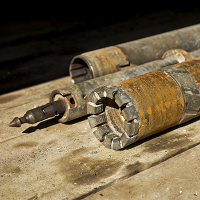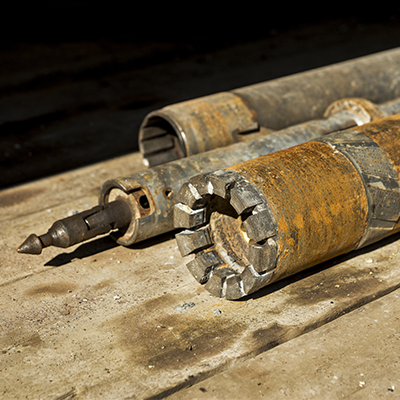Embrace exploration data to maximise exploration programs

Exploration drilling is critical to the success of your mine, regardless of commodity. It is also a hefty monetary investment.
During this stage, a vast amount of information is gathered on the potential economic material. This data is then used to inform resource models that can make or break the success of downstream mining activities.
However, while typical exploration data—such as core and/or chip samples, down hole geophysics, structural data, lithology description, and groundwater yield—is important, there is additional data that you should consider collecting during this stage to maximise your exploration investment.
A few types of ancillary exploration data
Trace fossil descriptions/collection
Trace fossils, such as shells from gastropods, can tell you about the chemical makeup of the rock you are working with. By collecting this data, you can more quickly identify formations and varying facies.
Facies descriptions
By capturing detailed facies descriptions, you will have a greater wealth of data that details changes in the depositional environment. With this data you will have more access to geologic indicators of potential ore locations.
Core/chip sample images
Sure, core/chip sample data is a typical data set for exploration. However, with this data generally recorded in a spreadsheet, visual cues about the material can be overlooked. By including images, you can expand the amount of recorded data by visually assessing the sample and catch additional, key information—such as whether or not the material has been oxidized.
Sieve tests
Completing sieve tests enables you to capture key data about grain size that can have hydrologic significance. With this data, you can also figure out how much of your material is being lost once it gets to your crusher, or mill.
Geotechnical Analysis
Geotechnical information, such as compressibility, bulk densities, etc. is crucial to understanding slope stability and how the material will act if there’s a failure. Capturing this data early allows you to plan and prepare for the specific behaviour of your material so that you are not caught off guard once the mine is in operation.
Material characteristics
By arming yourself with data around material characteristics, you can prepare your mine for how the material will behave under varying scenarios. For example, if you encounter bentonite during exploration, you can prepare for its swell factor that could cause future instability.
You could also collect data that could be used in Young’s Modulus and Poisson’s Ratio. Once operational drill & blast procedures begin, you will know how the material will heave when it’s shot—saving your mine both time and money during operations.
*It is important to note that there is such a thing as “too much data”. Don’t get distracted by trying to collect everything. But, if you notice an anomaly during exploration, it is worth the cost to go that extra mile now instead of trying to find funding later on.
Benefits of collecting ancillary exploration data
Going above and beyond what is mandated in the typical exploration stage can have significant benefits down the road. Three key benefits of collecting this “outside-the-box” exploration data include:
1. Increased resource model accuracy
With access to more exploration data, you can increase the accuracy of your initial resource model. This leads to more accurate tonnage estimates, which fuels a better mine plan and greater resource recovery.
Additionally, starting with a more accurate resource model helps ensure lower discrepancy rates during your resource model audit when the mine is in operation.
2. Enhanced understanding of your deposit
For many mines, complex geology can complicate production. Without an in depth knowledge of the material under the surface during the exploration phase, your downstream processes could become excessively complicated—causing a loss in revenue or missed projections.
Seemingly ‘ancillary’ data, such as material descriptions, seam or unit designation, as well as grain size of mineralisation could help you better understand what events coordinate to what types of assays, reducing the need for “model smearing”. Thus, with a more complete picture of your deposit you will have better production rates, reduced waste, and less dilution.
Even better? With a greater deposit understanding up front, you are likely to reduce the over-design of your mine, which will help bring overall operational expenses down for the life of the mine.
3. Improved life-of-mine processes
One of the biggest benefits to collecting more data during exploration is that you have it as a resource in the future.
When you’re in a later stage of the mining process, if an anomaly pops up, you can go back and audit your archive exploration data for insight. For example, let’s say your team comes across faulted or oxidized material during production in an area where they weren’t expecting to find variances. You can reference archived exploration data to help explain why this may have occurred—you may not have found explicitly faulted or oxidized material, but instead found indicators of these traits. This data then enables you to tell a more complete story of the geology in the immediate production area, thus adjusting operations to better take geologic information into account.
With access to this data, especially when paired with a mine planning software, you can cut down on operational costs—such as redrilling—and use your enhanced understanding to improve processes through the life of the mine.
Explore deeper
Collecting these “outside-the-box” exploration data sets may require a small, additional investment up front, but the benefits they bring further down the life of mine can greatly expand your mine revenue.
At the end of the day, a model is a model, but that model impacts a number of operations throughout the life of the mine. And the more tools you have at the start will boost downstream success.
Want to learn more about exploration data and how it can benefit your mine? Contact us today.



